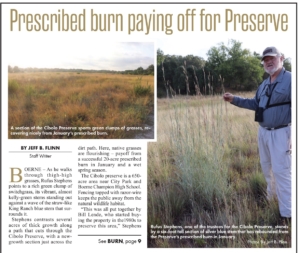Prescribed burn paying off for Preserve
BY JEFF B. FLINN • Staff Writer
(Boerne Star, July 23, 2023)
 BOERNE – As he walks through thigh-high grasses, Rufus Stephens points to a rich green clump of switchgrass, its vibrant, almost kelly-green stems standing out against a wave of the straw-like King Ranch blue stem that surrounds it.
BOERNE – As he walks through thigh-high grasses, Rufus Stephens points to a rich green clump of switchgrass, its vibrant, almost kelly-green stems standing out against a wave of the straw-like King Ranch blue stem that surrounds it.
Stephens contrasts several acres of thick growth along a path that cuts through the Cibolo Preserve, with a new growth section just across the dirt path. Here, native grasses are flourishing – payoff from a successful 20-acre prescribed burn in January and a wet spring season.
The Cibolo preserve is a 650acre area near City Park and Boerne Champion High School. Fencing topped with razor-wire keeps the public away from the natural wildlife habitat.
“This was all put together by Bill Lende, who started buying the property in the1980s to preserve this area,” Stephens said. “He had the vision to basically set it up as a nonprofit with the goal of managing the native habitats and providing research opportunities.” But the isolation of the natural habitat reaps benefits for the entire Hill Country, Stephens said. “The native habitat is benefitting the watershed, helping to improve water quality, groundwater recharge,” aspects that go beyond the perimeter fence.
“We manage the land for the native habitats and allow research to be conducted. We work with UTSA and we also work with Master naturalists who do citizen science,” he added.
Stephens shows the thick growth of switchgrass, the tall shoots of silver blue stem, and some Indian grass and wild rye.
“But there’s a significant amount of King Ranch blue stem, which is an exotic grass from the Middle East that was brought in and has spread all over the place,” Stephens said.
What looks like a wheat field is the dominant invasive KR blue stem creating conditions that blanket the soil, making it hard for native grasses to take hold and grow.
“Our King Ranch blue stem is dominant, but we can’t do anything about it,” he said. “People try to create conditions that are the most favorable for native grasses, and hope that we can slowly progress toward more natives and less exotics. But we’re probably always going to be living with it.”
Historically, Hill Country land was shaped by wildfires and grazing. “One of the challenges in managing the native habitats is realizing what the major ecological forces are,” he said. “Grazing by migrating herds of bison and fire were two ecological forces that the Hill Country was basically influenced by.”
Stephens came out to Cibolo preserve in 2017 after retiring from the Texas Parks and Wildlife Department, where he spent 23 years working mainly as an urban wildlife biologist. He most recently acted as district leader for the 25-county Edwards Plateau Wildlife District.
“When you don’t have the natural fires, or the grazing combination, then you end up with a lot of what we call ‘litter,’ he said, clearing away thick, twisted and entwined grass that masses right on top of the ground.
“There’s no place here where you see any bare ground. If you build up too much litter then you don’t have places for the diversity of plants to grow,” he said. “It will build up so much that it’ll start suppressing the grass itself. So, it’s detrimental in the long run to the native grasses.”
The prescribed burn, several months in the planning, occurred in the first week of January. A prescribed burn expert directed the preparation and strategically placed fire units from all area fire stations at various points around the fire’s perimeter.
The burn lasted only 1½-2 hours. But the results of the burn are still being weighed by Master Naturalists and by urban wildlife biologists like Stephens.
“The burn helps to maintain that balance of grasses, bare ground and wildflowers,” he said.
“The two sides (of the dirt path) are almost identical. But you can see how much more bare ground there is, wildflowers, that distribution, the Indian grass coming back – that’s not surprising. That’s what we expect. Grasses are adapted to that regular fire by having an extensive root system.”
The prescribed burn consumed all of 20 acres. “It was the first burn we’ve done as part of management, but we’d like to burn significant parts of the entire property,” he said.
“We’re looking at doing another prescribed burn this fall or winter.”
